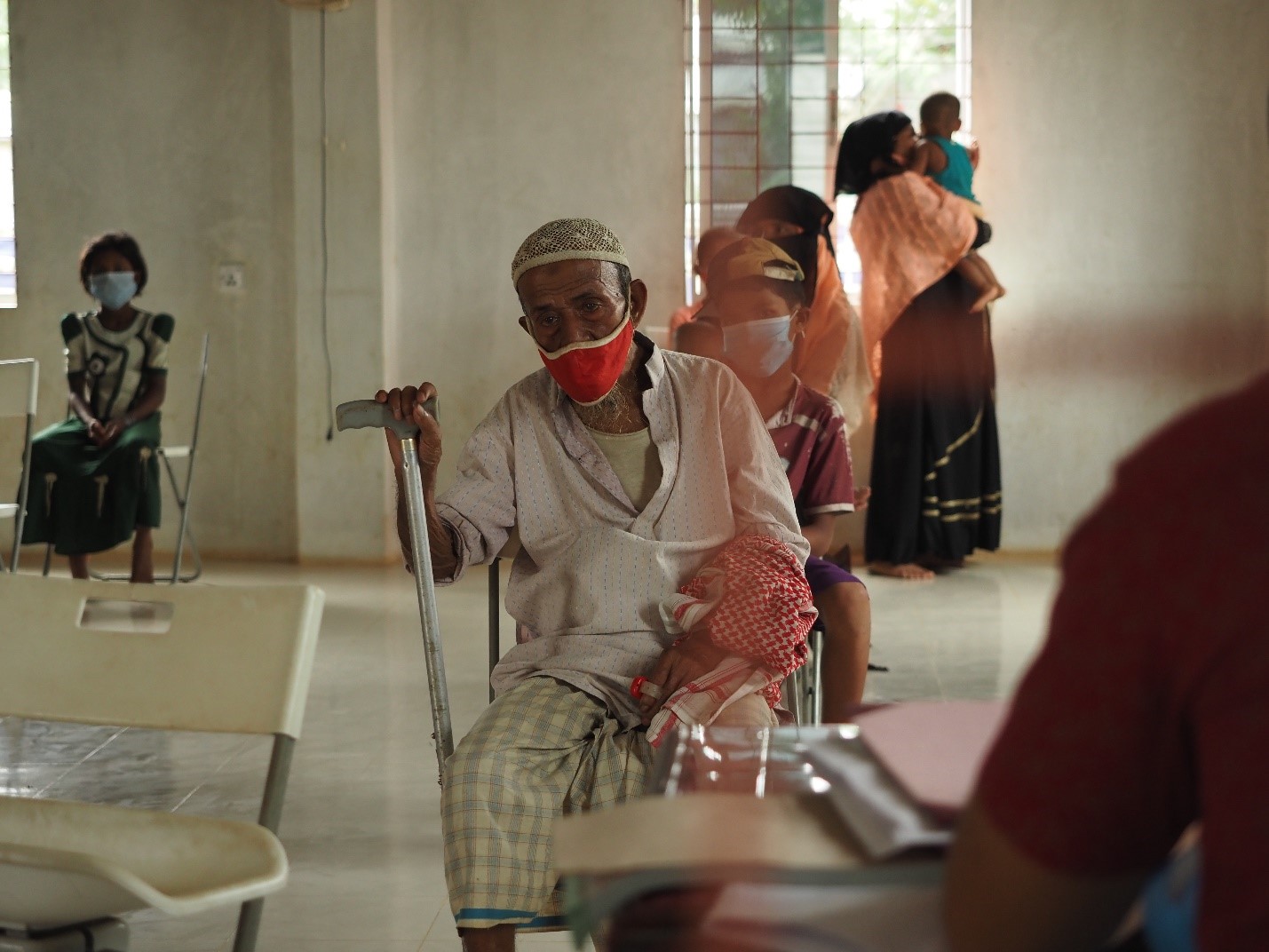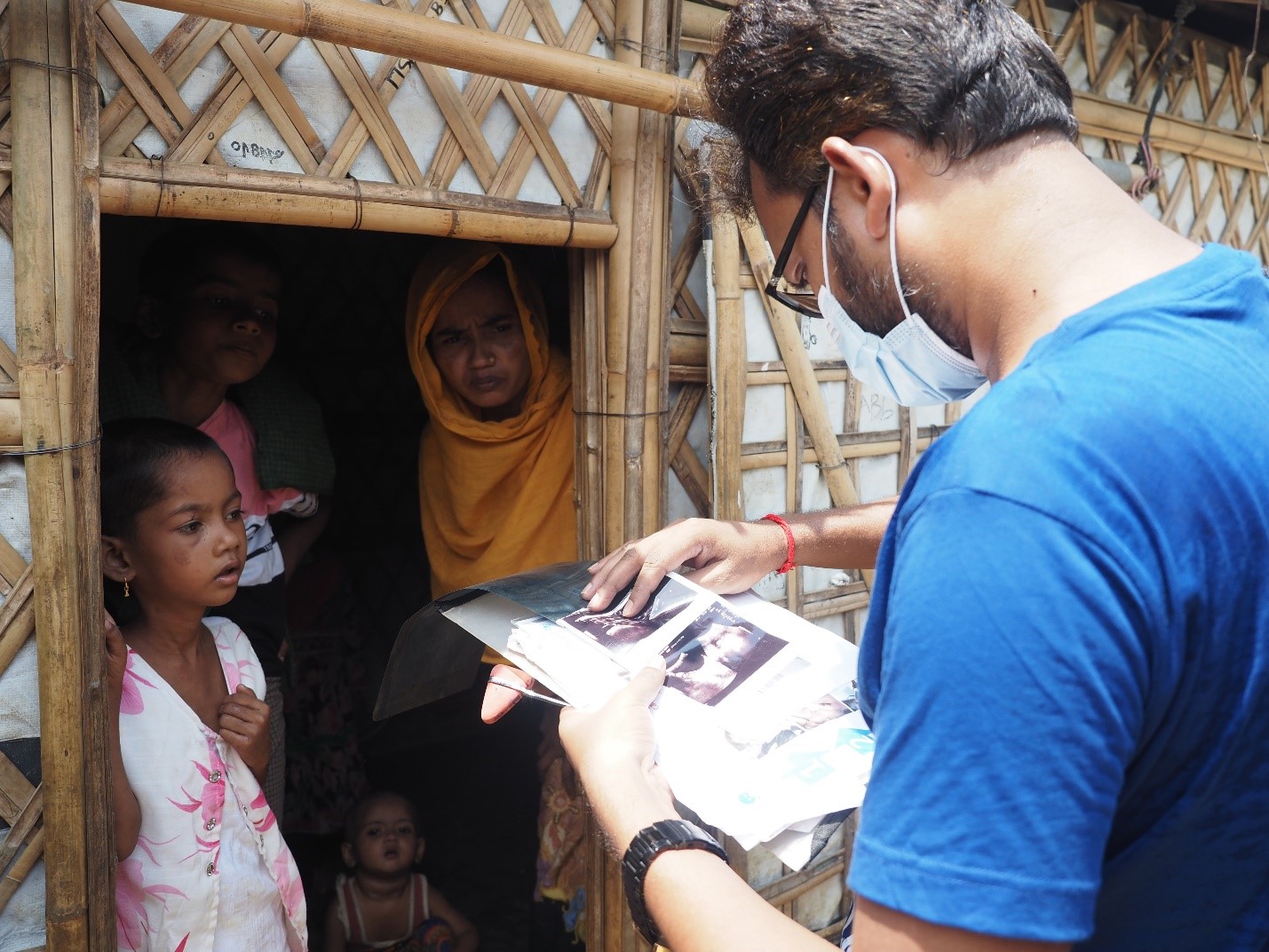More people are on the move now than ever before, yet migrants and refugees remain among the most vulnerable members of society and face continuous challenges to access quality healthcare.
In Cox’s Bazar, the scale of the humanitarian crisis combined with the overburdened healthcare services during the COVID-19 pandemic compounded the risk of poor health outcomes for the Rohingya refugee population. This threatened to compromise important progresses achieved over the four years of the humanitarian response.
Against this scenario, WHO and partners are supporting the Government of Bangladesh to respond to COVID-19 and ensure the continuous delivery of quality essential services in the Rohingya refugee camps despite the constraints imposed by the COVID-19 pandemic.
Access to primary health care and referrals for secondary facilities

Following screening for possible signs and symptoms of COVID-19, Rohingya patients wait to be triaged in a dedicated waiting area before consultation. WHO Bangladesh/ Irene Gavieiro Agud
There are 175 functional healthcare facilities in the Rohingya refugee camps offering a range of general healthcare services to nearly 884 000 Rohingya refugees and 472 000 Bangladeshi living in the surrounding areas. This includes primary healthcare centers, health posts, special facilities and field hospitals, where major surgeries occur if needed.
Additionally, as part of the COVID-19 pandemic response, in March 2020 WHO and partners established 14 Severe Acute Respiratory Infection Isolation and Treatment Centers (SARI ITCs) to provide quality clinical care to COVID-19 patients within this complex setting. With a capacity of nearly 1200 beds, these healthcare facilities can provide treatment for mild, moderate and severe cases of COVID-19 and ensure access to a secure oxygen supply 24 hours a day.
Every healthcare facility in the camps submits weekly reports to the WHO Early Warning, Alert and Response System (EWARS), an application for outbreak detection and response in emergency settings which enables systematic collection of real time data for disease surveillance. The use of EWARS provides an overview of the health status of the refugee population and becomes crucial in developing a more targeted and coordinated public health response, particularly in complex humanitarian settings such as Cox’s Bazar where a wide range of government and humanitarian actors are involved.
Partner-led healthcare centers in the camps coordinate efforts with the existing government facilities to ensure early access to life-saving treatment. In the case of the SARI ITCs, a well-established referral pathway enables the transfer of critical COVID-19 patients or patients with other serious pathologies to the ICU/HDU at Cox’s Bazar district Sadar Hospital, established months ago with the support of Government, UNHCR and WHO.
Communicable diseases beyond COVID-19

WHO Surveillance and Immunization Medical Officer (SIMO), Dr Sujit Paul, reviews the medical history of a Rohingya patient to rule out the diagnosis of infectious disease. WHO Bangladesh/ Irene Gavieiro Agud
Refugee and displaced populations living in humanitarian settings are often particularly susceptible to outbreaks of communicable diseases due to high population densities, poor sanitation and hygiene conditions. Since 2020, government authorities and humanitarian partners have employed all efforts to reduce the chance of COVID-19 transmission in the Rohingya refugee camps, and thus reduce mortality associated with the coronavirus in Cox’s Bazar district. However, common infectious diseases continue to be a serious threat for the Rohingya people and cannot be overlooked, particularly at this time when essential health services may be overwhelmed.
Surveillance and reporting mechanisms have been strengthened during the pandemic to monitor epidemiological data and guide outbreak response for priority communicable diseases. In 2021, most of the consultations reported through EWARS corresponded to Acute Respiratory Infections (ARI) and diarrheal diseases, followed by diphtheria and measles.
Progress made in communicable diseases surveillance since the beginning of the humanitarian response has been particularly beneficial to control the spread of the pandemic in the refugee camps. In 2019, WHO Bangladesh integrated Go.data –an outbreak investigation tool for field data collection during public health emergencies– to monitor the transmission of diphtheria cases in the Rohingya refugee camps. This software turned out instrumental for COVID-19 outbreak investigations in Cox’s Bazar, enabling case investigation, contact tracing and visualization of chains of transmission.
Noncommunicable Diseases: reducing premature deaths in a refugee setting

Following the national protocol for NCD screening, professionals at primary health care facilities test the blood pressure of every Rohingya patient above 40 years old. WHO Bangladesh/Irene Gavieiro Agud
Noncommunicable diseases (NCDs) –primarily heart and lung diseases, cancers and diabetes– are the world’s largest killers, with over 85 per cent of deaths occurring in low- and middle-income countries. In Bangladesh, NCDs are estimated to be the cause of 67% of all deaths.
Premature deaths from NCDs are largely caused by modifiable behavioral risk factors, such as tobacco use, physical inactivity or unhealthy diet. Hence, most of these diseases are preventable as they progress in early life. However, maintaining a healthy lifestyle is not always an easy feat when living in a refugee camp. Refugees are particularly vulnerable to NCDs and access to appropriate medical care can be challenging in this context.
In Cox’s Bazar, national protocols with particular focus on hypertension and diabetes have been integrated in the primary healthcare facilities in the camps using a total cardiovascular risk approach. This approach is based on the WHO Package of Essential Noncommunicable (PEN) disease interventions which includes capacity building for primary health care staff and community outreach workers, health promotion activities on NCD risk factors, supply of essential NCD commodities with gap-filling purpose, supportive supervision as well as strengthening NCD surveillance and monitoring in the district. Health promotion materials have been also distributed among primary health care facilities to raise awareness on healthy lifestyle among Rohingya patients.
Routine Immunization: envisioning a world free of vaccine-preventable diseases

Rohingya refugee woman shows her baby’s vaccination card before entering the immunization center. WHO Bangladesh/ Irene Gavieiro Agud
Upholding routine immunization has been a cornerstone for WHO in Cox’s Bazar since the onset of the Rohingya humanitarian response in 2017. With no previous history of vaccination, Rohingya people arrived in Cox’s Bazar with very low protection against vaccine-preventable diseases (VPD).
Since the first case of COVID-19 was detected in the Rohingya refugee camps, WHO in close coordination with the Government of Bangladesh and immunization partners developed a health-based transitional strategy to resume the routine immunization services. Currently, 59 health facilities are working as immunization fixed sites and another 66 vaccination teams are conducting outreach sessions both in community and healthcare facilities to guarantee the continuation of routine immunization programs.
Sexual Reproductive Health: ensuring safe and quality health services for women and girls

Nurses and midwifes play a crucial role in the SRH response, raising awareness among women, and encouraging community members to speak out against violence. WHO Bangladesh/ Irene Gavieiro Agud
Rohingya women and girls represent over half of the refugee population in Cox’s Bazar (52%) and approximately 24.5% are women of reproductive age. While the provision of Sexual Reproductive Health (SRH) care has improved since the beginning of the humanitarian response in Cox’s Bazar, access to these services still remains a point of concern.
Women refugees are extremely vulnerable to negative SRH outcomes due to limited knowledge on menstruation, menopause, sexually transmitted infections, and unwanted pregnancy. In this regard, ensuring quality of both primary and secondary maternity services is essential for an integrated SRH response. During the pandemic, WHO and UNFPA have been providing medical equipment, supplies, essential commodities and guidelines for maternity services in the camps, to ensure that patients and staff are protected, and that women have access to emergency care during COVID-19.
Reducing the likelihood of maternal deaths has been a priority for WHO in Cox’s Bazar. At the onset of the influx in 2017, just 22% of deliveries were estimated to have occurred in health facilities. This number increased to 67% in December 2020 due to a joint community engagement strategy with UNHCR which addresses social beliefs and fears around facility-based deliveries and raises awareness on sexual and reproductive health education among both men and women.
Prevention of Sexual violence has also been strengthened during the COVID -19 pandemic. WHO continues collaborating with key partners in Cox’s Bazar to build capacities on Protection Against Exploitation and Abuse (PSEA) in order to make healthcare facilities a safe place where women and girls can seek quality health services, and thus stop the cycle of violence. The Health Sector has developed a Gender Action Plan for 2021 in line with the Joint Response Plan (JRP) for the Rohingya Humanitarian Crisis of the Government of Bangladesh and humanitarian partners.
Mental Health and Psychosocial Support: building an empathetic and skilled workforce

Skilled and empathetic healthcare professionals increase trust in the health care system among patients and reduce the stigma associated with mental health diseases. WHO Bangladesh/ Irene Gavieiro Agud
It is recognized that common mental health conditions increase significantly among emergency affected populations.
In addition, the COVID-19 pandemic is expected to have a massive impact on people’s mental well-being, including refugee populations.
For patients with existing mental health conditions, the support of empathetic and proactive mental health workers is instrumental to slowly start rebuilding their lives after a crisis Through capacity building, WHO encourage frontline healthcare workers in the camps to feel confident to talk about mental health and know how to provide primary support and refer patients when psychosocial support is needed.
